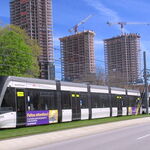urbancog
Active Member
When is that going to be built?
Construction start 2022, taking two years. So, likely to open after the Eglinton LRT.
When is that going to be built?
It's a shame that the rest of the Kitchener line won't be electrified.
That was my thinking too. The Bombardier Bi-Level is such a great design that it has become almost the defacto rolling stock choice for new commuter rail services in North America. I'm sure a metro area looking to either start a service or expand upon a minimal service (thinking SunRail or something like that) would be eager to scoop up some of the coaches that GO no longer needs. Commuter rail outfits in their infancy, especially in the States, look to do stuff on the cheap, so saving a few million bucks in rolling stock cost could cover an additional station or two for them.In addition, there are 12 other railways which operate Bombardier BiLevel coaches, and there may be opportunities to sell off a few units here or there. It would be quite cost-effective to fill those needs by having a standing order for EMUs with a few delievered each year as required. As new EMUs arrive, they could displace the electric locomotives on the core local services. Those would be redeployed onto express services as the outer portions of lines get electrified.
May get a short form of non-commercially sensitive info - operational, maintenance, and performance standards, plus outlining any at risk revenue.I wonder if the actual bid package from Alstom will be released to the public realm. What made them the winning bid? Are they technically better or they just undercut the loser on price?

 blog.metrolinx.com
blog.metrolinx.com

New GO Expansion agreement with ONxpress Transportation Partners ushers in exciting future of faster, greener, more frequent GO Train service - Metrolinx News
GO Expansion is moving forward to the next stage of development and will transform the region in ways greater than previously imagined. GO Expansion will include infrastructure and operational plans that reduce journey times even more, add more capacity, improve on-time performance, and customer...blog.metrolinx.com
Includes a short video with people from the consortium speaking.
it's much better travel time improvements than what they were thinking of in the business case by the sounds of it too - making allusions that Oakville GO will be about 25 minutes from Union for example, compared to the expected 31 minute travel time in the business case.Those speed ups are huge
About pickering, trains run express from it, so other than top speed, i dont see how much it could change. even EMUs shouldnt affect it that muchit's much better travel time improvements than what they were thinking of in the business case by the sounds of it too - making allusions that Oakville GO will be about 25 minutes from Union for example, compared to the expected 31 minute travel time in the business case.
This is a substantial improvement in essentially every way, and is very, very exciting.
What is odd though is that Pickering GO is alluded to also be 25 minutes from Union, despite that being the projected travel time in the Business Case. So the travel time savings clearly aren't universal across all lines.
Things like frequent, sub-1hr travel times to Hamilton, 1.25hrs to Barrie, etc. will also be revolutionary in easing travel around the region.
I'd reserve judgment on the travel times until actual track testing. So many things need to go right in order for these better than business case scenarios to work. There's a few low hanging fruits like ROWs. I wonder if it'll mean running 6 or 8 car trains during rush on the lakeshoreit's much better travel time improvements than what they were thinking of in the business case by the sounds of it too - making allusions that Oakville GO will be about 25 minutes from Union for example, compared to the expected 31 minute travel time in the business case.
This is a substantial improvement in essentially every way, and is very, very exciting.
What is odd though is that Pickering GO is alluded to also be 25 minutes from Union, despite that being the projected travel time in the Business Case. So the travel time savings clearly aren't universal across all lines.
Things like frequent, sub-1hr travel times to Hamilton, 1.25hrs to Barrie, etc. will also be revolutionary in easing travel around the region.




